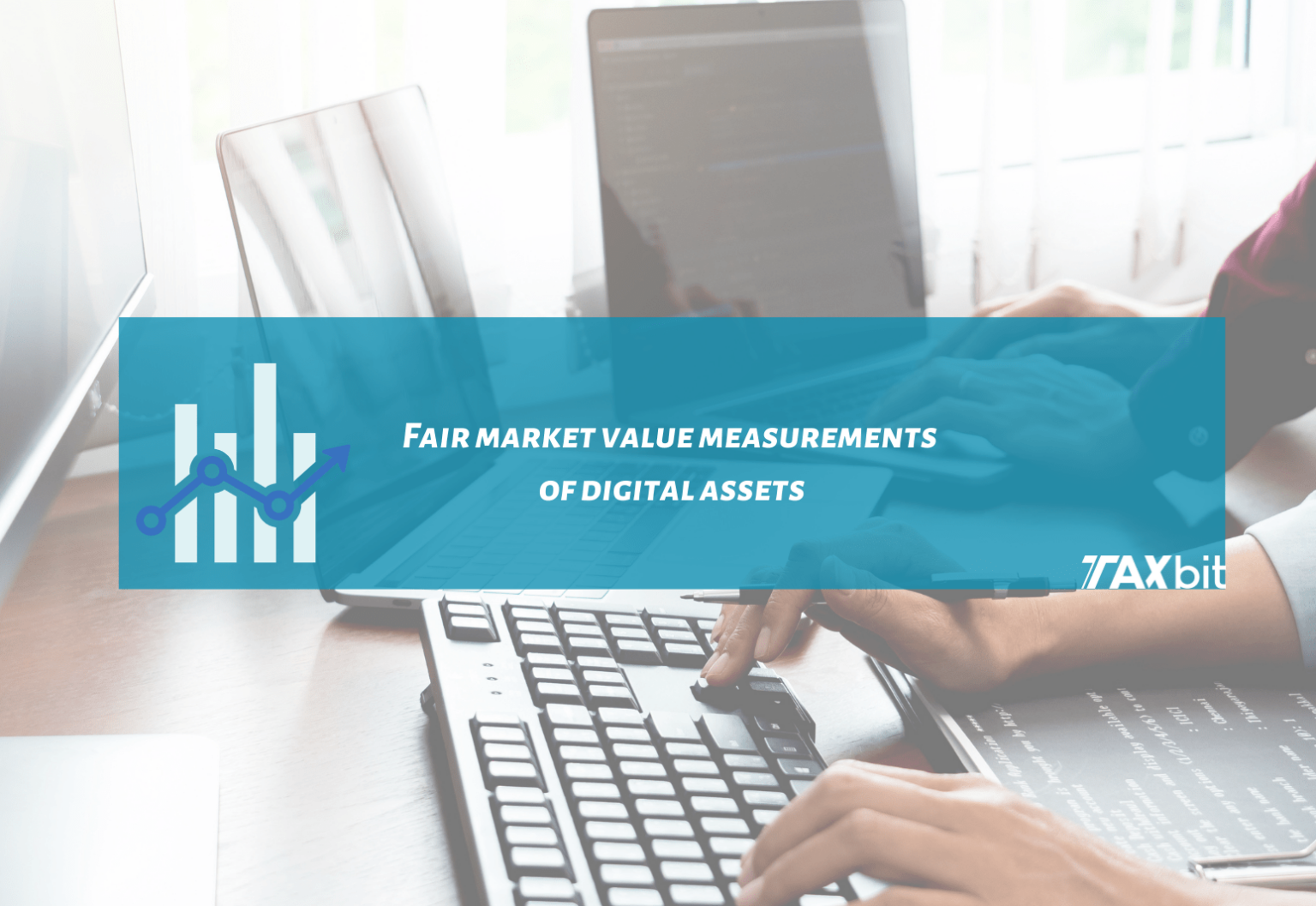How to determine the principal market to use in fair market value measurements of digital assets
The current regulatory reporting framework for cryptocurrencies and other digital assets requires companies to report these assets as indefinite-lived intangible assets, or in other words, hold at cost minus impairment. Industry stakeholders have banded together to push for more targeted guidance specific to digital assets. Many stakeholders are petitioning the FASB and advocating for fair value treatment. Accounting firms and internal finance executives are left to interpret existing guidance to determine how to report all of the nuances and complexities of cryptocurrency most accurately. As companies navigate existing guidance, several instances have been identified in which a digital asset requires fair-value pricing for accurate reporting in the financial statements. Some of the most common examples include:
- Pricing to determine accurate, fair value reporting of custodied holdings ( SAB 121 article)
- Pricing to determine the fair value of digital asset liabilities (e.g., Loans)
- Pricing throughout the reporting period to determine accurate impairment on corporate holdings (The Challenge to Tracking Impairment)
- Pricing on acquisition or disposition transactions (buys, sells, or trades) to establish cost basis at the time of acquisition and proceeds at the time of disposition
- Pricing to determine fair value in order to support unrealized gain/loss positions for management or other stakeholder reporting.
Fair Value Framework
CPAs and finance executives are perhaps most familiar with the fair value determination guidance ASC 820. This authoritative guidance, as established in U.S. Generally Accepted Accounting Principles (GAAP), provides a framework for determining the fair value of an asset. This same guidance currently applies to cryptocurrencies and other digital assets when determining fair value in any of the scenarios listed in the section above, or any other scenario which requires fair-value reporting. In the ASC 820 guidance, fair value determination methods are divided into a hierarchy based on the level of information available to determine the fair value of an asset:
- Level 1 valuations are supported by quoted prices in active markets for identical assets or liabilities that the entity can access at the measurement date
- Level 2 valuations are supported by observable market inputs other than Level 1 inputs
- Level 3 valuations are supported by unobservable market inputs
In the current digital asset landscape, it is likely that most enterprises are primarily dealing in Level 1 assets; however, it should be noted that there are also many types of digital assets that do not actively trade on an open market and therefore lack observable price inputs. It is also not uncommon for assets to switch back and forth from active trading on an open market with readily available pricing to suddenly being unavailable to trade on an open market and require Level 3 inputs for valuation, and vice versa. In the absence of Level 1 observable price inputs, enterprises are required to deploy other valuation methods.
Identifying an Active Market
The first step in assessing whether your assets can be valued using Level 1 inputs is determining if an active market exists. While the ASC 820 guidance does not provide specific thresholds for determination, the guidance requires that the asset transactions in the market must occur with sufficient frequency and volume to provide pricing information on an ongoing basis for that market to fit the definition of an active market.
Identifying the Principal Market
In many cases, you will likely find that there is more than one active market for the asset(s) you are trying to value. This is where the more frustrating part of the analysis kicks in – when there are multiple markets to select the pricing from, which market should you choose? Do you use the same pricing source for all of your assets? Can you simply use your favorite exchange to get pricing for all of your assets?
ASC 820-10-35-3 states that “A fair value measurement assumes that the asset or liability is exchanged in an orderly transaction between market participants to sell the asset or transfer the liability at the measurement date under current market conditions.” Paragraph 35-5 then goes on to say, “A fair value measurement assumes that the transaction to sell the asset or transfer the liability takes place either: a) the principal market for the asset or liability, or b) the most advantageous market for the asset of liability.”
According to paragraphs 5 through 6A in ASC 820-10-35, you are required to collect pricing information from the assets’ “principal market.” This concept of a Principal Market is critical to understand to support fair value measurements for digital assets. Because asset pricing is a critical input to determining fair value measurements, this is an area that receives careful consideration and scrutiny from companies, their external auditors, and even the SEC. There are two important components to determining the principal market for each asset:
- Which of the active markets do you have access to trade on?
- Of the markets you have access to, which has the greatest trading volume for the asset?
For a simple example, let’s assume you hold Bitcoin on your balance sheet that requires fair value measurement. Let’s also assume you have access to trade Bitcoin on five U.S. exchanges: Coinbase, Binance, FTX, Gemini, and Kraken.
In this example, even if you do a majority of your Bitcoin trading on the Kraken exchange, if Coinbase is deemed to be the Principal Market due to it having the highest trade volume, then you would still likely be required to use pricing from Coinbase for your Bitcoin fair value measurements.
While the above example is very simple, this gets more complicated when you hold multiple assets that each have a different principal market. For example, assume you also hold some Dogecoin in addition to your Bitcoin holdings. If, for example, the exchange with the highest trading volume for Dogecoin is Binance, but the exchange with the highest volume for Bitcoin is Coinbase, then you would have to collect fair value price information from Binance for your Dogecoin fair value measurement, and Coinbase for your Bitcoin fair value measurement.
Due to the number of available assets and trading markets in the crypto space, it is likely that the principal market for one asset in your holdings will differ from another. It is also likely that the principal market for some assets will change from time to time. Tracking these changing variables can quickly become very difficult and costly for enterprises.
Current accounting guidance does not prescribe the exact way or approach a company must use in order to determine an assets’ Principal Market. Rather, it requires that an analysis is performed that is reasonable, robust, and supportable (i.e. a company should feel confident presenting to its auditors what was done to determine the Principal Market and be able to quantitatively support that ultimate conclusion). In addition, the guidance notes the following, which should be considered:
- “A reporting entity need not undertake an exhaustive search of all possible markets to identify the principal market or, in the absence of a principal market, the most advantageous market, but it shall take into account all information that is reasonably available.” ASC 820-10-35-5A
- “If there is a principal market for the asset or liability, the fair value measurement shall represent the price in that market, even if the price in a different market is potentially more advantageous at the measurement date.” ASC 820-10-35-6
- “The reporting entity must have access to the principal market at the measurement date. Because different entities with different activities may have access to different markets, the principal market for the same asset or liability might be different for different entities. Therefore, the principal market shall be considered from the perspective of the reporting entity, thereby allowing for differences between and among entities with different activities. ” ASC 820-10-35-6A
Additional Considerations
Once the principal market is determined for each asset held or custodied, enterprises are still faced with the additional complexity of applying fair value pricing to different assets at different times depending on reporting requirements. Some of these additional complexities include the following:
- For assets reported at fair value – how to collect pricing information at consistent times each reporting period. Enterprises must first determine what date and time during the period they will collect price information to mark assets at fair value and then be consistent across reporting periods (E.g. the last day of each month at 4:00 PM EST).
- For assets reported at cost – how to capture intraday pricing changes for impairment calculations (link to impairment article).
- Establishing internal policies approved by key internal stakeholders and even the Board, to provide clear and consistent application of the selected approach.
How Can Taxbit Help?
Due to the complexity, volume, and rapid growth of crypto transactions, you’ll want to seek out and leverage technology to help you.
Taxbit employs a team of world-class software engineers and CPAs who design and develop technology tools that are specifically tailored to help companies navigate the complexities of digital asset tax reporting and accounting.
Taxbit’s Corporate Accounting Suite performs principal market analysis for an enterprise’s entire digital asset holdings and applies the correct Level 1 pricing inputs at the transaction level to facilitate seamless GAAP compliance.
.png)


